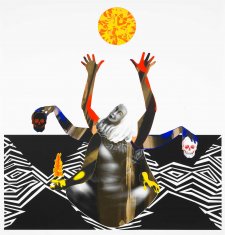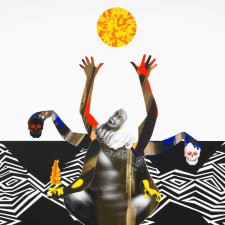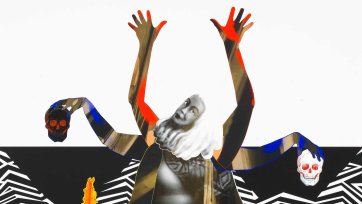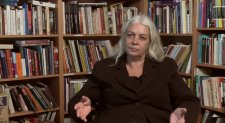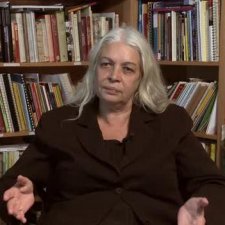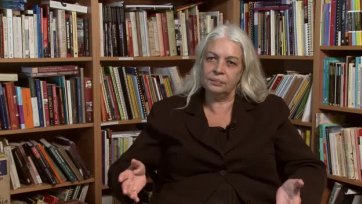Marcia: I think Brook and I chatted away for about two years before he executed the work and he had an idea much earlier on to do something like this for another show and it didn’t eventuate because the ideas in the show grew like topsy and so this didn’t really fit in at the time.
Brook: So it was the natural progression, but unfortunately at the time I didn’t have the scope and it was a much bigger project and so Marcie went on the backburner. But actually it was meant to be because then Chris Chapman contacted me a few years ago and said “Brook, would really like to commission you to do a portrait of Marcia Langton and how do you feel about that”? And it was perfect for the National Portrait Gallery because she’s such an important figure.
Marcia: He had the idea of using some ideas from Hindu mythology and expressing them in an artistic way, to depict aspects of the life of an Aboriginal person as a dynamic, flowing series of events rather than the boring old static idea of the Aborigine in Australian mythology, yeah?
Brook: If you don’t understand the different disciplines of anthropology ... some people think oh, anthropology’s just only about the bones and about indigenous people, etcetera, but there are quite a few indigenous anthropologists and it’s very important. So I wanted to show that, but it was also about balance, so there was a black skull and a white skull. In a lot of my work I have binary opposites and these things even popped up in Anthony Mundine’s Hope and Peace, so you had hope on one side and peace on the other. So really the symbols that I kept in Marcia’s portrait was still very similar to the Mundine. So if you have them both up together, and I do hope that they’ll be both shown together some time soon, you will see the absolute similarities.
Marcia: So he was bringing to bear on basically, you know, pretty conventional Australian mythology about Aboriginal people, his wealth of knowledge about Hindu society and history and religious mythology, in a very interesting way. So that idea of the cycle of life and death and the dynamism of you know being human he wanted to inject into a work of art, and he wanted me as the subject. And so we started talking about what’s important in my life.
Brook: The other symbolism in Marcia’s portrait is the wiradjuri pattern, but it’s a lot more like a river, and so I really wanted that to flow like energy. So that’s kind of like an energy force behind it. And the fire is in her right hand and so she’s ... well, one of her hands, ‘cause she has six hands, and I’ll get to that in a minute. And so it’s about magic and it’s about being a magic person and fire. And the other left hand is in a meditative pose. And then the skulls and then the two hands up are holding the diamond, which is a sun as well.
Marcia: And of course he knew that I’d written a lot about traditional Aboriginal use of fire and traditions of fire management, so he was fascinated with that because fire’s a very important symbol in Hindu mythology as it is in many religions. He knew that I had worked at the Argyle Diamond Mine and of course in Buddhism you have the Diamond Sutra and the diamond represents the multi-faceted effect of, well, let’s say purity, yeah, of peace, yeah? So he was bringing together elements from his world and my world.
Brook: Then, with these elements, they were really developed in the studio as well, weren’t they, the skulls?
Trent: No, a lot of it came through the process. And I think originally we tried some lightning as well.
Brook: Yes, we had lightning too, but that ...
Trent: And at some point there was some text, do I recall?
Brook: Yes, there was peace, because originally there were going to be two diamonds, there were going to be a peace diamond and a conflict diamond, but scrap that.
Trent: Yeah, so I guess there were things developed in the studio that didn’t make the final work. And I’d say that’s probably ... Brook is a very dynamic artist and works quite intuitively in a practical way and in a process way. So the portrait really evolved from his studio session to what you did on the computer.
Brook: Mm, mm.
Trent: And so the image of Marcia you see just isn’t a straight kind of a photographic portrait, obviously not with all the different elements, but even just if you literally just take her portrait, her face, I feel that there’s some softened lines and there’s this real softness to it.
Brook: Mm, mm, and the hairs been exaggerated.
Trent: Yeah.
Brook: So it’s this kind of wavy hair that kind of goes on and on.
Marcia: The idea of Kali came up. He first of all did some black and white drawings and he showed me those and I could see where he was headed with it. And so we just kept talking, and then eventually this idea of Kali popped up and he started working with that. And then I did a sitting.
Brook: So the process of the portrait was Marcia sitting for that photographic shoot first and I had her pose in different meditative poses. And then I imported that as a digital file into the computer and I changed certain aspects of it so it didn’t look so much like a photographic portrait, so it was almost cartoon-esque. And then I selected certain parts of the body with Trent.
Trent: Mm.
Brook: So for example we had the body and then we had the arms and then we had the head and we outputted those onto screen.
Trent: Yeah, mm.
Brook: Onto a screen print.
Trent: Yes, we had films, we had film made from Brook’s files. So you can imagine there’s an arm, there’s a head, there’s a body, so they’re all quite separate from the start. So in a way that was like making a collage in reverse.
Marcia: So Brook’s very good at capturing something about the body. He did that also in his Kalar Midday series with his photographs of Tina and other characters in the trees in the night sky. So I wrote about that in my essays on his work and so I was hoping that somehow he would be able to do that with me and actually he’s gone beyond that in this work. And that’s what I really love about the work. I heard people grumbling at the opening night, oh opening day when they showed it to the public, it was the evening actually, at the National Portrait Gallery, and people were saying that, “It’s not what I think of as a portrait, doesn’t look like a portrait to me,” but you see I think it is because I know what went into it. So he’s captured me juggling all sorts of things but it’s not just me, you see? It’s a big idea in there. It’s a very big idea.
Brook: But yeah, the printing of the work was a lot of experimentation. We were in Trent’s studio.
Trent: Mm.
Brook: And I played with painting on the screen to you know ...
Trent: And you tried hand colouring as well.
Brook: Hand colouring, yep.
Trent: And we did a lot of things in the studio here, at Brook’s studio, just putting things up and moving things around. As you can tell from the finished work it’s quite a large piece so to be able to see it all at once was a challenge in my studio.
Brook: Yeah, so we’d stick it up here and stand up here and look at it down here and it was good. And I’m always an artist that I love challenging the medium, so I kind of said to Trent, “Well let’s do this,” and he says to me, “Yeah, let’s do that.” So it’s been … I just didn’t want this to be a screen print. This is not just ... I don’t see this portrait as a screen print portrait. I see this as a portrait representing Marcia. And so those elements in the way in which we got to finally make decisions about how those elements are cut out, how they were actually floating, so in the frame, when you look at the frame it is a collage. So there are what, three, six, seven, eight, nine ...
Trent: Lots of (9:14).
Brook: Ten, 11, 12, 13, 14 elements that bring it together.
Trent: Yeah.
Brook: And you know portraiture is so much more than a painting.
Trent: Mm.
Brook: It’s so much more than the traditional way of looking at somebody and I think that the way in which that we worked right from the beginning of her sitting still, so really she did sit for it anyway, and I did change it digitally a little bit. It became almost like a cartoon but not, and it’s not really fixed, so it’s believable but it’s not, but it’s also a caricature but it’s not.
Trent: Mm.
Brook: And so it’s these sort of things that are not ... I didn’t want it to be a defining portrait. I didn’t want it to be okay, that’s a snapshot, that’s a photograph. I think it needed to be a bit more in the dream world as well and I think that that was really more about capturing her consciousness.
Marcia: And so what he’s done is taken this idea of Kali, yeah, and put the two together, my private persona, my public persona, then added Kali and I think taken apart altogether, undone the conventional mythology about the Aboriginal portrait, the portrait of an Aborigine. And I’m absolutely thrilled at the outcome. It’s so big and bold and colourful and lively. It kind of doesn’t matter that it’s me or somebody else. It’s a meta statement about the portrait of an Aborigine, yeah, but it could be about any human being as well. But I like what he’s done, I really like what he’s done and I love it that he’s taken really fundamental, elemental symbols, the diamond and fire and skull and so on, and the meditation or even yoga position and looking towards the other world, yeah, the state of grace. He’s taken all of that to make a much bigger statement than a simple portrait about which people might wonder, “Well it’s not a very good likeness, is it dear?” It doesn’t matter. That’s not the point. This is a meta statement. And I think in many ways he’s captured more about me than a conventional portrait would.
Brook: And then we showed Marcia and she said that it’s ... the first time she saw it was when she was at the National Portrait Gallery when it was being launched, which I thought was funny because I’d sent her images of it but ... she loved it, so, and I think it was ... she did see certain elements of it but not as a whole, and I like that. But I’m so happy that she likes it, and her daughter likes it too so that’s really important.
Marcia: I think the curators at the National Portrait Gallery were very brave for giving this commission to Brook and allowing him to present them with a work that he was very happy with. And I’m thrilled that they’re happy with it and I’m also very honoured to be in the National Portrait Gallery.
